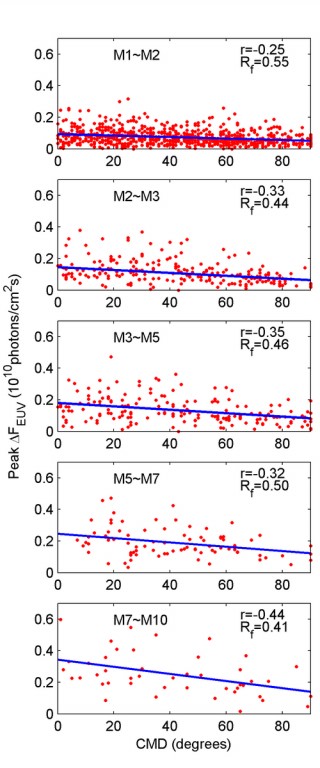Postdoctor LE Huijun and his teacher LIU Libo analyze the relationship between enhancement in X-ray flux and that in solar extreme ultraviolet (EUV) flux during solar flares in 1996-2006. They use the 0.1-0.8 nm X-ray flux data and 26-34nm EUV flux data.
The correlation coefficients between enhancements in EUV and X‐ray flux for X, M and C‐class flares are only 0.66, 0.58 and 0.54, respectively, which suggests that X‐ray flux is not a good index for EUV flux during solar flares. Thus, for studying more accurately solar flare effect on the ionosphere/thermosphere system, one needs to use directly EUV flux measurements. One of important reasons for depressing relationship between X‐ray and EUV is that the central meridian distance (CMD) of flare location can significantly affect EUV flux variation particularly for X‐class flares: the larger value of CMD results in the smaller EUV enhancement. However, there are much smaller CMD effects on EUV enhancement for M and C‐class flares.
The solar disc images from SOHO/EIT are utilized to estimate the percentage contribution to total EUV enhancement from the flare region and from other region. The results show the larger percentage contribution from other region for the weaker flares, which would reduce the loss of EUV radiation due to limb location of flare and then weaken the CMD effect for weaker flares like M and C‐class.

Figure 1. Dependence of the enhancement EUV flux on the values of CMD which represent the location of flares on the solar disc for M-class flares of 1996–2006. (Image by LE)

Figure 2. Dependence of the enhancement EUV flux on the values of CMD which represent the location of flares on the solar disc for X‐class flares of 1996–2006.(Image by LE)
Le et al. Statistical analysis of solar EUV and X‐ray flux enhancements induced by solar flares and its implication to upper atmosphere. Journal of Geophysical Research. 2011, 116, A11301 (Download Here)